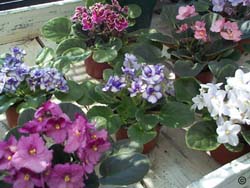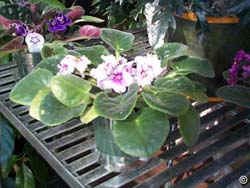African violets are a favorite flowering house plant. They are easy to grow, they adapt well to home growing conditions, they are easily propagated from a leaf cutting and they bloom continually all year.

African violet cultivars range from miniatures (plants six inches or less in diameter) to large (over 16 inches in diameter). Flowers come in many colors including bi-colored and multi-colored forms. Flower shapes come in single, double, semi-double, fringed, and ruffled, and leaves come in types including ruffled, scalloped, quilted, and variegated. For more information about the various classes and cultivars of African violets, visit the African Violet Society of America (http://www.avsa.org/l).
 African violets require the proper amount of light for good bloom. The plants often will retain normal color when they don’t get enough light, but they will rarely bloom, and leaf blades will become thin, with elongated petioles (leaf stems). When the light is too bright, growth slows and leaves become pale or yellowish green and leathery.
African violets require the proper amount of light for good bloom. The plants often will retain normal color when they don’t get enough light, but they will rarely bloom, and leaf blades will become thin, with elongated petioles (leaf stems). When the light is too bright, growth slows and leaves become pale or yellowish green and leathery.
Eastern and northern exposures provide ideal light conditions, but filtered light in south or west windows also is acceptable. In addition, African violets grow well under artificial light, often blooming more profusely than in natural light. If fluorescent light is the only light source, you will need approximately 600 footcandles of light for 15 hours per day. Two 40-watt fluorescent tubes suspended 12 to 15 inches above the plants will provide enough light. For best results, use the wide spectrum fluorescent tubes. However, regular tubes plus one or two incandescent bulbs will also provide enough light.
Night-time temperatures for African violets should be between 65 to 70 degrees Fahrenheit, and day-time temperatures should be between 75 to 85 degrees. At low temperatures, the leaves on the plants turn dark, appear water-soaked, and eventually die. Plants grown on a window sill can be easily damaged by low temperature conditions, and may freeze if they touch the glass.
African violets appreciate high humidity. Use of a humidifier or placing plants on a metal or plastic container filled with gravel, perlite, or sand with a shallow layer of water in the container bottom will provide necessary humidity. Be sure you do not set the bottom of the pot directly in the water.
When repotting African violets, use potting soils specifically blended for these plants. Soils for growing African violets need to remain loose and well-drained for several years. African violets can be grown in nearly any container as long as it has drainage holes. Position the plant crown slightly above the rim of the planter. If using a clay pot, use foil or some tape along the rim of the pot to keep the leaf petioles from rotting.
As a general rule, water African violets only when the soil surface feels dry. Never wait until the soil becomes hard or the plants begin to wilt. Apply enough water each time to thoroughly saturate the soil, and be sure to discard any excess water collected through the bottom of the pot. To prevent spotting, avoid splashing cold water on the leaves.
Most water-soluble house-plant fertilizers are suitable for African violets. Apply fertilizer according to the manufacturer’s recommendations. As a general rule, plants should be fertilized every four to six weeks. If the leaves become pale green and the plant begins producing fewer and smaller flowers, it’s time to fertilize. Over-fertilization is usually a bigger problem than under-fertilization.
To propagate African violets, use one of the following methods:
- cut off a young leaf with its stalk and immerse the stalk in warm water. New roots will arise from the stalk and can be planted immediately
- Break off a healthy leaf at the stem of the plant. Place the petiole (stalk) into a rooting media of coarse sand, vermiculite, or half vermiculite and half sand. Firm gently and water thoroughly. Cuttings root best at 65° to 75°F with a high relative humidity.
To divide old plants with multiple crowns, cut the crowns with a sharp razor blade so that each has a portion of the original root system. Enclose the plant in a ventilated plastic bag to maintain high humidity and prevent wilting until the new root system develops.
Be sure that all tools and working surfaces are clean to prevent disease transmission. A solution of 5% chlorine bleach (i.e. 1 tsp bleach in 2 cups of water) can be used to clean tools, pots and potting benches.
For more information, see the following Planttalk Colorado™ video(s).



